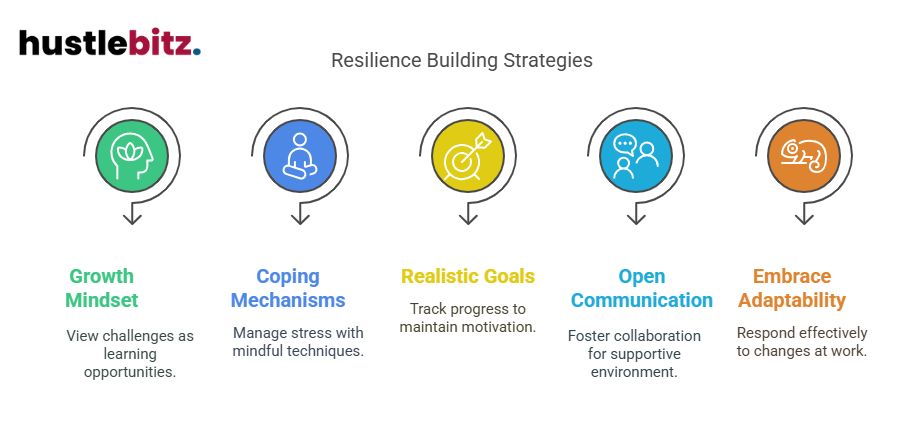Building resilience at work is vital for navigating challenges effectively. Key strategies include fostering a positive mindset that views obstacles as learning opportunities and identifying stress triggers to manage reactions. Developing healthy coping mechanisms, such as mindful breathing and physical activity, enhances emotional well-being. Setting realistic goals provides clear direction, while flexibility and adaptability promote a supportive environment. Learning from setbacks encourages growth and the identification of constructive responses. By cultivating optimism and teamwork, employees can significantly strengthen their resilience. Explore further to discover additional strategies that can enhance resilience in your workplace.
Key Takeaways
- Cultivate a growth mindset by viewing challenges as opportunities for learning and development in the workplace.
- Develop healthy coping mechanisms such as mindful breathing and creative outlets to manage stress effectively.
- Establish realistic goals and track progress to maintain motivation and provide a clear roadmap for overcoming obstacles.
- Foster open communication and collaboration within teams to create a supportive work environment that enhances resilience.
- Embrace flexibility and adaptability to respond effectively to change, thereby strengthening resilience in the face of challenges.

Understanding Resilience

Resilience in the workplace refers to the ability of individuals and teams to adapt, recover, and thrive amidst challenges and setbacks. This resilience definition encompasses not only bouncing back from adversity but also leveraging experiences for personal growth and enhanced team dynamics.
Emotional intelligence plays a pivotal role in resilience, as it enables individuals to recognize and manage their emotions, fostering effective stress management.
Workplace support systems significantly bolster resilience, providing employees with the resources they need to confront difficulties. Implementing resilience training programs can equip teams with adaptive strategies that promote a proactive approach to obstacles. Such training often incorporates principles of positive psychology, encouraging a mindset that views challenges as opportunities for development rather than insurmountable barriers.
A comprehensive resilience assessment can help organizations identify strengths and areas for improvement within their teams. By understanding individual and collective resilience levels, employers can tailor support initiatives that align with their workforce’s unique needs.
Furthermore, fostering a culture that values open communication and collaboration enhances workplace resilience. When team members feel supported and connected, they are more likely to exhibit resilience during stressful times.
Ultimately, cultivating resilience in the workplace not only improves employee well-being but also contributes to organizational success, as resilient individuals and teams are better equipped to navigate the complexities of today’s work environment.
The Importance of Mindset
A positive mindset is crucial for navigating challenges at work, as it influences how individuals perceive and respond to adversity.
Adopting a growth mindset allows employees to view obstacles as opportunities for learning and development. This perspective fosters optimism and encourages positive thinking, enabling individuals to overcome negativity that may arise during stressful situations.
Engaging in self-reflection practices is essential for enhancing self-awareness, as it helps individuals identify their reactions to challenges and emotional triggers. By nurturing curiosity, employees can explore alternative solutions and innovate in the face of adversity.
Embracing challenges rather than avoiding them reinforces resilience, allowing for the development of essential skills and building confidence.
Furthermore, cultivating gratitude is a powerful tool that can shift focus from problems to positive aspects of work life. This practice can improve overall job satisfaction and foster a supportive work environment.
A mindset rooted in gratitude encourages collaboration and strengthens team dynamics, which are crucial for resilience.
Recognizing Stress Triggers
Identifying stress triggers is essential for employees to effectively manage their reactions and cultivate a healthier work environment. Stress awareness begins with recognizing the specific situations or interactions that provoke anxiety or discomfort. By developing emotional intelligence, individuals can better understand their own responses and those of their colleagues, facilitating improved communication styles that mitigate misunderstandings.
Personal boundaries play a critical role in stress recognition. Employees must learn to assert their limits, especially in a fast-paced workplace environment where demands can easily overwhelm. Effective time management also helps in identifying stress triggers; overloaded schedules can lead to feelings of inadequacy and burnout. By prioritizing tasks and allocating time wisely, employees can reduce stress levels significantly.
Moreover, understanding team dynamics is crucial. Poor collaboration or unresolved conflicts can escalate stress levels, making conflict resolution skills invaluable. Encouraging open dialogue within teams fosters a supportive atmosphere, allowing members to express their concerns and alleviate tensions.
Incorporating self-care practices into daily routines is another key strategy for recognizing stress triggers. Regular physical activity, mindfulness exercises, and adequate rest contribute to overall well-being, enhancing resilience against stress.
Ultimately, by identifying and addressing their stress triggers, employees can prevent burnout and create a more harmonious workplace environment. This proactive approach not only benefits individual health but also strengthens team cohesion and productivity, leading to a more resilient organization.
Developing Healthy Coping Mechanisms

Recognizing stress triggers lays the groundwork for developing healthy coping mechanisms that can enhance individual well-being and productivity in the workplace. Effective coping strategies empower individuals to manage stress constructively, fostering resilience.
Here are three essential practices that can serve as a foundation for this development:
- Mindful Breathing: This technique encourages individuals to focus on their breath, promoting relaxation and reducing anxiety. A few minutes of mindful breathing can reset one’s mental state, allowing for clearer thinking and decision-making.
- Positive Affirmations: Engaging in positive self-talk can significantly improve self-esteem and motivation. Affirmations help to reframe negative thoughts, reinforcing a mindset geared towards growth and resilience.
- Creative Outlets: Pursuing creative activities, whether through art, music, or writing, provides an essential release for emotions and stress. These outlets stimulate the brain and can lead to innovative problem-solving in work tasks.
Incorporating physical activity, nurturing social connections, and practicing time management also play vital roles in this process. Setting healthy boundaries and establishing a journaling practice can further enhance resilience, allowing individuals to reflect on experiences with self-compassion.
Additionally, gratitude exercises can foster a positive outlook, transforming challenges into opportunities for growth. By adopting these healthy coping mechanisms, individuals can better navigate workplace stress, ultimately leading to improved productivity and overall well-being.
Setting Realistic Goals

Establishing realistic goals is fundamental to fostering resilience in the workplace, as it provides a clear roadmap for individuals to navigate challenges and measure progress effectively. Goal setting enables employees to develop realistic expectations, ensuring they do not overextend themselves. By employing effective time management and prioritization skills, individuals can allocate their resources wisely, focusing on achieving milestone achievements that are both attainable and relevant to their professional growth.
To enhance motivation techniques and maintain momentum, it is beneficial to incorporate progress tracking methods. This approach allows individuals to visualize success, keeping them engaged and motivated throughout their journey. Collaborating with accountability partners can further bolster commitment, as shared goals encourage mutual support and celebration of achievements.
Here is a summary of the key elements involved in setting realistic goals:
| Key Elements | Description |
| Goal Setting | Define clear and specific objectives. |
| Realistic Expectations | Ensure goals are achievable and relevant. |
| Progress Tracking | Monitor advancement towards goals regularly. |
| Celebrating Achievements | Acknowledge and reward milestone accomplishments. |
Embracing Flexibility and Adaptability

Embracing flexibility and adaptability in the workplace is crucial for navigating the ever-evolving challenges and demands of modern professional environments. Organizations that foster a culture of flexible thinking enhance their capacity to respond to change effectively. This adaptability is not merely reactive; it involves proactive planning and the implementation of innovative strategies that anticipate future needs.
To cultivate this environment, consider the following key elements:
- Open Communication: Encouraging dialogue among team members enhances teamwork dynamics and ensures that everyone is aligned with organizational goals.
- Continuous Learning: Investing in professional development empowers employees to embrace change acceptance and equips them with the skills necessary for creative problem solving.
- Adaptive Leadership: Leaders must model flexibility, demonstrating how to pivot strategies in response to new information or shifting priorities.
By prioritizing these aspects, organizations can effectively manage resources and improve overall performance. The ability to adapt not only strengthens resilience but also enriches the workplace culture, promoting a sense of belonging and collaboration.
Ultimately, organizations that embrace flexibility and adaptability can thrive amidst uncertainty. They cultivate a workforce that is prepared to face challenges head-on, fostering a collaborative spirit that leads to sustainable success. In this way, resilience becomes an integral part of the organizational ethos, enabling teams to bounce back and continue moving forward, regardless of the obstacles they encounter.
Learning From Setbacks

Setbacks are not merely obstacles; they serve as invaluable opportunities for growth and learning that can significantly enhance resilience in the workplace. By engaging in failure analysis, individuals can dissect what went wrong, fostering a growth mindset that views challenges as stepping stones rather than roadblocks. This approach encourages the development of feedback loops, where insights gained from setbacks inform future strategies, facilitating continuous improvement.
Incorporating emotional intelligence during these times is crucial, as it allows individuals to manage their emotions and respond constructively to adversity. This self-awareness paves the way for personal development, enabling employees to identify areas for improvement and to take proactive steps toward their goals. Furthermore, effective risk assessment can help teams anticipate potential setbacks, thus minimizing their impact and preparing them to bounce back more swiftly.
Reflective practices, such as journaling or peer discussions, can enhance learning from setbacks and solidify the lessons learned. Additionally, fostering strong support networks within the workplace creates a safety net where individuals can share experiences and strategies for overcoming challenges.
Optimism training can also play a vital role, as it cultivates a positive outlook that helps individuals remain motivated despite difficulties.
Final Thoughts
Building resilience in the workplace is essential for navigating challenges with strength and adaptability. By fostering a growth mindset, developing healthy coping mechanisms, and setting realistic goals, employees can not only bounce back from adversity but also thrive. Embracing flexibility, learning from setbacks, and maintaining strong communication and teamwork are key to creating a supportive and resilient work environment. By incorporating these strategies, individuals and organizations alike can cultivate resilience, enhancing both personal well-being and collective success in today’s dynamic professional landscape.




